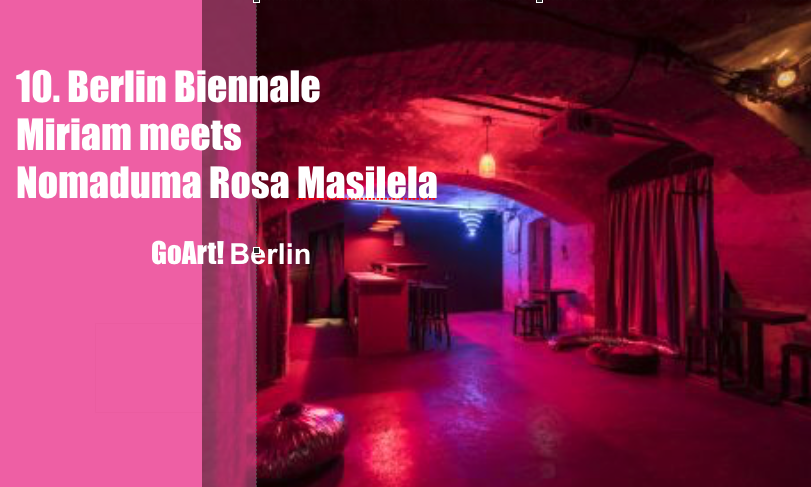The 10th Berlin Biennale is on display until September 9th, 2018. Under the title ‚We do not need another hero‘, Gabi Ngcobo’s team of five curators has brought together 46 artistic positions dealing with political and social events, power structures and historiography away from the Eurocentric perspective, with a focus on African or South American contemplations.
Miriam Bers spoke with Nomaduma Rosa Masilela, one of the co-curators of the 10th Berlin Biennale:
MB: What expectations did you have when you came to Berlin – how was /how is the work here as a curator for the 10th Berlin Biennale? How international is the scene compared to New York, what inspired you, what surprised you and what disappointed you?
NRM: I lived in New York for over a decade, spending nearly all of my 20s in the art ‘scene’ there, therefore I’m not sure if I am yet at all able to provide any real comparison to the Berlin scene, which I have really only been experiencing for less than a year. While I don’t think that many cities can compare to the international quality of the New York scene, a difference that I have noted is that while the forces of the capital are overwhelmingly present and influential in New York, the Berlin scene appears more directed by state/singular funding sources, which dictate the direction and overall interests of the season. What has inspired me the most about Berlin has been meeting the many artists who live in this city, sharing their work, and being able to imagine a way of collaboration in a much more free way than what is possible in New York, in which most activities are centered around a concern for a profit or popularity margin.
MB: It is very inspiring that the curatorial team of the 10th Berlin Biennale has managed to combine politics with poetry. You comprehend the message of many works without knowing all the details and backgrounds. Themes such as colonialism and oppression characterize the style of the exhibition venues – without a moral pointing finger, but with different artistic worlds partly involving the viewer. For example, The participatory performance of Okwui Okpokwasili and Peter Born in the Kunst Werke, which deals with one of the most important women’s protests in the world, incorporates the viewer, asks them questions that in a next step link them to lyrics or songs. Can this be understood as a work in progress, as a new story?
NRM: Okwui Okpokwasili and Peter Born’s project, Sitting on a Man’s Head (2018) was a newly commissioned work for the 10th Berlin Biennale, however it is the result of ongoing research that far predates their involvement with the biennale. Okwui’s research into this practice, and its implementation in the early 20th century in Nigeria, informed earlier performance productions, such as Poor People’s TV Room. However, this specific iteration, which we produced for the biennale was really only possible within the context of an ongoing exhibition. Also, the ongoing participation of both activators and audience members, which is so integral to the piece, is also reflective of the ongoing nature of protest and its resultant possibilities of change.
MB: In the Academy of Arts, Firelei Baez shows her version of Sanssouci. Sanssouci as a former ruler and today’s artistic desire place? What is the story of the Haitian Sanssouci and what do we learn from it? What message does Firelei Baez attach to her work?
NRM: I think this question can best be answered through reading the beautiful essays that Portia Malatjie wrote about Firelei’s Sanssouci project in the biennale catalogue and exhibition guide. Portia’s essay clearly explains the importance of the Haitian Sanssouci and of the Haitian Revolution, not only within Firelei’s practice and this biennale, but also as a model for the necessary changes that need to occur. Firelei insists that by layering or ‘triangulating’ histories, one is able to open up a third space of enunciation – one of possibility.
MB: Last but not least in a few words: What is your key message and what’s coming next?
NRM: We have avoided providing keys throughout the exhibition, as that eliminates any of the interesting work that one has to do in interpreting and deciding how things are on ones own. What we want is for each viewer to be able to engage with the works and have their own feelings; to question themselves and the structures that they have possibly always taken for granted; and in so doing, to create new possibilities of being and of imagining the world and those within it.
As for me, what’s next – I’m now based in Berlin, having moved permanently from New York in February, and am currently prioritizing completing and submit a dissertation for the department of art history at Columbia University in New York. I am also focusing on making my own art work and planning a sister publication to the curatorial publication that I organized for the biennale, Strange Attractors, which combined commissioned works by contemporary artists (such as Temitayo Ogunbiyi, Mame Diarra Niang, Adrijana Gvozdenovic, and Beau H. Rhee) with archival materials (the herbarium pages of Rosa Luxemburg, the sketchbook of Mildred Thompson, and notebooks of both Octavia Butler and Audre Lorde) in order to look at the comforts and complications of familial love and communication.

